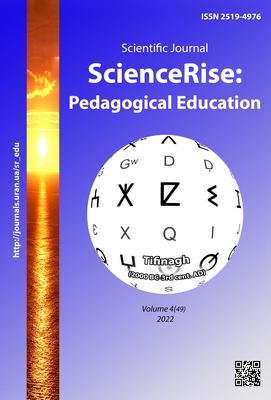Choir ensemble issues in the process of forming professional competences of the future teacher-musician
DOI:
https://doi.org/10.15587/2519-4984.2022.261308Keywords:
formation of professional qualities of future music teachers, choral ensemble, types of choral ensembleAbstract
The question of the special importance of a music teacher in the development of choral culture, which significantly affects the preservation of spiritual values of the younger generation, is considered. The issue of choral ensemble in the process of formation of professional qualities of students of musical specialties of pedagogical educational institutions is covered. One of the professional competencies of a music teacher is the organization and management of vocal and choral activities. It is noted, that for a successful professional activity the teacher-choirmaster needs to understand the importance of the choral ensemble in working with choirs, be able to use different types of ensemble for quality choral sound. A special place in working with the choir is occupied by the feeling of the ensemble, the ability to adjust the choral sonority in accordance with the author's intention to reveal the artistic image.
The essence of the concept of «choral ensemble» is defined and the main types of it are characterized. It is specified, that the choral ensemble is the artistic unity of all components of choral sound and the merging in strength and timbre of individual voices in one choral part and the balance of sound between all parts of the choir. The importance of using such concepts as partial and general, natural and artificial ensemble in the training of future music teachers is revealed. Partial ensembles include ensembles of intonation, combat, timbre, dynamic, metrorhythmic, agogic, diction-orthoepic and tessitura. It is indicated what factors influence the choice of a particular type of ensemble. A number of regularities of the ensemble, which follow from the texture of the musical work, are highlighted. The use of different types of ensemble in practice is described on the examples of choral works. A detailed analysis of all types of choral ensemble is covered in the unaccompanied choral score by L. Shukailo «Oh, on Kupala» from the cantata «Seasons»
References
- Garnett, L. (2005). Сhoral singing as bodily regime. IRASM. Croatian Musicological Society, 36 (2), 249–269.
- Strimple, N. (2002). Choral Music in the Twentieth Century. Portland: Amadeus Press, 298.
- Puchko-Kolesnyk, Yu. V. (2009). Diialnist dyryhenta-khormeistera yak sotsiokulturnyi fenomen. Kyiv, 18.
- Chai, J. J. (2019). Postminimalist choral music: a pedagogical perspective. Theses and Dissertations-Music, 135. doi: http://doi.org/10.13023/etd.2019.101
- Doroniuk, V. D. (2010). Dyryhent shkilnoho khoru. Ivano-frankivsk: PNU im. V. Stefanyka, 61–78.
- Tkach, Y. (2012). The particularity of the conducts interpretation in the choir performance. Available at: https://parafia.org.ua/biblioteka/kultura/spetsyfika-dyryhentskoji-interpretatsiji-u-horovomu-vykonavstvi/
- Kazachkov, S. A. (1990). Ot uroka k kontcertu. Kazan: Izd-vo Kazanskogo unmversiteta, 343.
- Sbitnieva, O. F. (2017). Khoroznavstvo. Starobilsk: Vyd-vo DZ «LNU imeni Tarasa Shevchenka», 86.
- Yatlo, L. P. (2009). Teoriia ta metodyka roboty z dytiachym khorom. Uman: RVTs «Sofiia», 120–126.
- Kushnir, K. V., Sidorova, I. S. (2021). Khoroznavstvo ta khorove aranzhuvannia. Vinnytsia: Tvory, 191.
- Gregorio, D. (2012). An Analysis of Two Choral Compositions With Strings by Tarik O’Regan. University of Southern California, 99.
Downloads
Published
How to Cite
Issue
Section
License
Copyright (c) 2022 Iryna Sidorova

This work is licensed under a Creative Commons Attribution 4.0 International License.
Our journal abides by the Creative Commons CC BY copyright rights and permissions for open access journals.
Authors, who are published in this journal, agree to the following conditions:
1. The authors reserve the right to authorship of the work and pass the first publication right of this work to the journal under the terms of a Creative Commons CC BY, which allows others to freely distribute the published research with the obligatory reference to the authors of the original work and the first publication of the work in this journal.
2. The authors have the right to conclude separate supplement agreements that relate to non-exclusive work distribution in the form in which it has been published by the journal (for example, to upload the work to the online storage of the journal or publish it as part of a monograph), provided that the reference to the first publication of the work in this journal is included.








